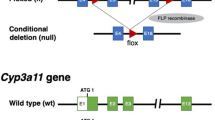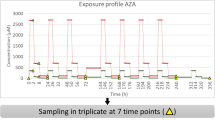Abstract
Aim:
To characterize the metabolism of cardamonin by the P450 enzymes in human and animal liver microsomes.
Methods:
Cardamonin was incubated with both human and animal liver microsomal incubation systems containing P450 reaction factors. High performance liquid chromatography coupled with ion trap mass spectrometry was used to identify the metabolites. Serial cardamonin dilutions were used to perform a kinetic study in human liver microsomes. Selective inhibitors of 7 of the major P450 isozymes were used to inhibit cardamonin hydroxylation to identify the isozymes involved in cardamonin metabolism. The cardamonin hydroxylation metabolic capacities of human and various other animals were investigated using the liver microsomal incubation system.
Results:
Two metabolites generated by the liver microsome system were detected and identified as hydroxylated cardamonin. The Km and Vmax values for cardamonin hydroxylation were calculated as 32 μmol/L and 35 pmol·min−1·mg−1, respectively. Furafylline and clomethiazole significantly inhibited cardamonin hydroxylation. Guinea pigs showed the highest similarity to humans with respect to the metabolism of cardamonin.
Conclusion:
CYP 1A2 and 2E1 were identified as the P450 isozymes involved in the metabolism of cardamonin in human liver microsomes. Furthermore, our research suggests that guinea pigs could be used in the advanced pharmacokinetic studies of cardamonin in vivo.
Similar content being viewed by others
Log in or create a free account to read this content
Gain free access to this article, as well as selected content from this journal and more on nature.com
or
References
Wang S, Zhou L, He W, Hu Z . Separation and determination of alpinetin and cardamonin by reverse micelle electrokinetic capillary chromatography. J Pharm Biomed Anal 2007; 43: 1557–61.
Chinese Pharmacopoeia Commission (China). Pharmacopoeia of the People's Republic of China. Beijing: People's Medical Publishing House; 2005.
Kimura Y, Takahashi S, Yoshida I . Studies on the constituents of Alpinia: XII: on the constituents of the seeds of Alpinia katsumadai hayata: I: the structure of cardamomin. Yakugaku Zasshi 1968; 88: 239–41.
Rao CB, Rao N, Suryaprakasam S . Cardamonin and alpinetin from the seeds of Amomum subulatum. Planta Med 1976; 29: 391–2.
Dong H, Chen SX, Xu HX . A new antiplatelet diarylheptanoid from Alpinia blepharocalyx. J Nat Prod 1998; 61: 142–4.
Wang ZT, Lau CW, Chan FL, Yao X, Chen ZY, He ZD, et al. Vasorelaxant effects of cardamonin and alpinetin from Alpinia henryi K. Schum. J Cardiovasc Pharmacol 2001; 37: 596–606.
Ahmad S, Israfa DA, Lajis NH, Shaari K, Mohamed H, Wahab AA, et al. Cardamonin, inhibits pro-inflammatory mediators in activated RAW 264.7 cells and whole blood. Eur J Pharmacol 2006; 538: 188–94.
Hatziieremia S, Gray AI, Ferro VA, Paul A, Plevin R . The effects of cardamonin on lipopolysaccharide-induced inflammatory protein production and MAP kinase and NFkappaB signalling pathways in monocytes/macrophages. Br J Pharmacol 2006; 149: 188–98.
Walsky RL, Boldt SE . In vitro cytochrome P450 inhibition and induction. Curr Drug Metab 2008; 9: 928–39.
Froy O . Cytochrome P450 and the biological clock in mammals. Curr Drug Metab 2009; 10: 104–15.
Nebert DW, Dalton TP . The role of cytochrome P450 enzymes in endogenous signalling pathways and environmental carcinogenesis. Nature 2006; 6: 947–60.
Bachmann KA, Ghosh R . The use of in vitro methods to predict in vivo pharmacokinetics and drug interactions. Curr Drug Metab 2001; 2: 299–314.
Howgate EM, Rowland Yeo K, Proctor NJ, Tucker GT, Rostami-Hodjegan A. Prediction of in vivo drug clearance from in vitro data. I: impact of inter-individual variability. Xenobiotica 2006; 36: 473–97.
Obach RS, Walsky RL, Venkatakrishnan K, Gaman EA, Houston JB, Tremaine LM . The utility of in vitro cytochrome P450 inhibition data in the prediction of drug-drug interactions. J Pharmacol Exp Ther 2006; 316: 336–48.
Gradolatto A, Canivenc-Lavier MC, Basly JP, Siess MH, Teyssier C . Metabolism of apigenin by rat liver phase I and phase II enzymes and by isolated perfused rat liver. Drug Metab Dispos 2004; 32: 58–65.
Silva ID, Rodrigues AS, Gaspar J, Laires A, Rueff J . Metabolism of galangin by rat cytochromes P450: relevance to the genotoxicity of galangin. Mutat Res 1997; 393: 247–57.
Tolleson WH, Doerge DR, Churchwell MI, Marques MM, Roberts DW . Metabolism of biochanin A and formononetin by human liver microsomes in vitro. J Agric Food Chem 2002; 50: 4783–90.
Kulling SE, Honig DM, Metzler M . Oxidative metabolism of the soy isoflavones daidzein and genistein in humans in vitro and in vivo. J Agric Food Chem 2001; 49: 3024–33.
Breinholt VM, Offord EA, Brouwer C, Nielsen SE, Brosen K, Friedberg T . In vitro investigation of cytochrome P450-mediated metabolism of dietary flavonoids. Food Chem Toxicol 2002; 40: 609–16.
Sanderink G, Bournique B, Stevens J, Petry M, Martinet M . Involvement of human CYP1A isoenzymes in the metabolism and drug interactions of riluzole in vitro. J Pharmacol Exp Ther 1997; 282: 1465–72.
Lowry OH, Rosebrough NJ, Farr AL, Randall RJ . Protein measurement with the Folin phenol reagent. J Biol Chem 1951; 193: 265–75.
Wang Y, Yang L, He YQ, Wang CH, Welbeck EW, Bligh SWA, et al. Characterization of fifty-one flavonoids in a Chinese herbal prescription Longdan Xiegan Decoction by high-performance liquid chromatography coupled to electrospray ionization tandem mass spectrometry and photodiode array detection. Rapid Commun Mass Spectrom 2008; 22: 1767–78.
Wang DL, Liang Y, Chen WD, Xie L, Wang GJ, Liu XD . Identification of ginkgolide B metabolites in urine and rat liver cytochrome P450 enzymes responsible for their formation in vitro. Acta Pharmacol Sin 2008; 29: 376–84.
Fabre N, Rustan I, de Hoffmann E, Quetin-Leclercq J . Determination of flavone, flavonol, and flavanone aglycones by negative ion liquid chromatography electrospray ion trap mass spectrometry. J Am Soc Mass Spectrom 2001; 12: 707–15.
Liu HX, Liu Y, Zhang JW, Li W, Liu HT, Yang L . UDP-glucuronosyltransferase 1A6 is the major isozyme responsible for protocatechuic aldehyde glucuronidation in human liver microsomes. Drug Metab Dispos 2008; 36: 1562–9.
Liu L, Pang KS . An integrated approach to model hepatic drug clearance. Eur J Pharm Sci 2006; 29: 215–30.
Obach RS, Baxter JG, Liston TE, Silber BM, Jones BC, Macintyre F, et al. The prediction of human pharmacokinetic parameters from preclinical and in vitro metabolism data. J Pharmacol Exp Ther 1997; 283: 46–58.
Houston JB . Utility of in vitro drug metabolism data in predicting in vivo metabolic clearance. Biochem Pharmacol 1994; 47: 1469–79.
Bjornsson Td, Callaghan Jt, Einolf Hj, Fischer V, Gan L, Grimm S, et al. The conduct of in vitro and in vivo drug-drug interaction studies: a phrma perspective. Drug Metab Dispos 2003; 31: 815–32.
Huang SM, Temple R, Throckmorton DC, Lesko LJ . Drug interaction studies: study design, data analysis, and implications for dosing and labeling. Clin Pharmacol Ther 2007; 81: 298–304.
Harris JW, Rahman A, Kim BR, Guengerich FP, Collins JM . Metabolism of taxol by human hepatic microsomes and liver slices: participation of cytochrome P450 3A4 and an unknown P450 enzyme. Cancer Res 1994; 54: 4026–35.
Griffiths LA, Smith GE . Metabolism of apigenin and related compounds in the rat. Metabolite formation in vivo and by the intestinal microflora in vitro. Biochem J 1972; 128: 901–11.
Walsky RL, Obach RS . Validated assays for human cytochrome p450 activities. Drug Metab Dispos 2004; 32: 647–60.
Racha JK, Rettie AE, Kunze KL . Mechanism-based inactivation of human cytochrome P450 1A2 by furafylline: detection of a 1:1 adduct to protein and evidence for the formation of a novel imidazomethide intermediate. Biochemistry 1998; 37: 7407–19.
Gebhardt AC, Lucas D, Menez JF, Seitz HK . Chlormethiazole inhibition of cytochrome P450 2E1 as assessed by chlorzoxazone hydroxylation in humans. Hepatology 1997; 26: 957–61.
Doostdar H, Burke MD, Mayer RT . Bioflavonoids: selective substrates and inhibitors for cytochrome P450 CYP1A and CYP1B1. Toxicology 2000; 144: 31–8.
Acknowledgements
This work was partially supported by grants from the National Natural Science Foundation of China (No 30530840, 30772608), Key Project of Chinese National Programs for Fundamental Research and Development (973 Program, No 2006CB504704) and Shanghai Science & Technology Development Foundation (No 04DZ19851), the Greeting Fund of Dalian Institute of Chemical Physics, Chinese Academy of Science (No K2006A23).
Author information
Authors and Affiliations
Corresponding authors
Rights and permissions
About this article
Cite this article
He, Yq., Yang, L., Liu, Y. et al. Characterization of cardamonin metabolism by P450 in different species via HPLC-ESI-ion trap and UPLC-ESI-quadrupole mass spectrometry. Acta Pharmacol Sin 30, 1462–1470 (2009). https://doi.org/10.1038/aps.2009.127
Received:
Accepted:
Published:
Issue date:
DOI: https://doi.org/10.1038/aps.2009.127
Keywords
This article is cited by
-
Pharmacokinetic interactions of clopidogrel with quercetin, telmisartan, and cyclosporine A in rats and dogs
Archives of Pharmacal Research (2012)



